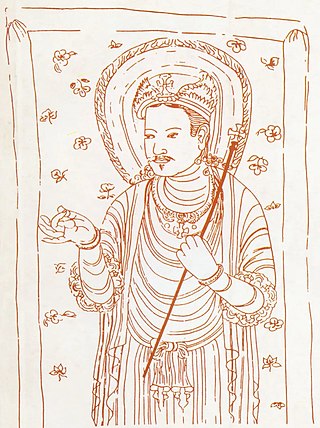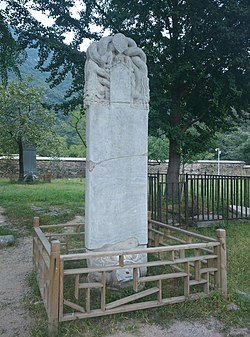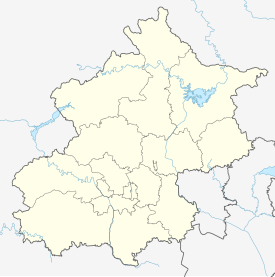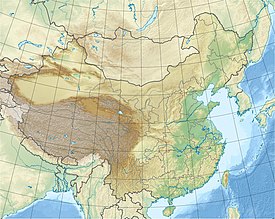
Luoyang is a city located in the confluence area of the Luo River and the Yellow River in the west of Henan province. Governed as a prefecture-level city, it borders the provincial capital of Zhengzhou to the east, Pingdingshan to the southeast, Nanyang to the south, Sanmenxia to the west, Jiyuan to the north, and Jiaozuo to the northeast. As of December 31, 2018, Luoyang had a population of 6,888,500 inhabitants with 2,751,400 people living in the built-up area made of the city's five out of six urban districts and Yanshi District, now being conurbated. By the end of 2022, Luoyang Municipality had jurisdiction over 7 municipal districts, 7 counties and 1 development zone. The permanent population is 7.079 million.

The Daqin Pagoda is a Buddhist pagoda in Zhouzhi County of Xi'an, Shaanxi Province, China, located about two kilometres to the west of Louguantai temple. The pagoda has been claimed as a Church of the East from the Tang dynasty.
The Xi'an Stele or the Jingjiao Stele, sometimes translated as the "Nestorian Stele," is a Tang Chinese stele erected in 781 that documents 150 years of early Christianity in China. It is a limestone block 279 centimetres high with text in both Chinese and Syriac describing the existence of Christian communities in several cities in northern China. It reveals that the initial Church of the East had met recognition by the Tang Emperor Taizong, due to efforts of the Christian missionary Alopen in 635. According to the stele, Alopen and his fellow Syriac missionaries came to China from Daqin in the ninth year of Emperor Taizong (635), bringing sacred books and images. The Church of the East monk Adam composed the text on the stele. Buried in 845, probably during religious suppression, the stele was not rediscovered until 1625. It is now in the Stele Forest in Xi'an.

The Church of the East historically had a presence in China during two periods: first from the 7th through the 10th century in the Tang dynasty, when it was known as Jingjiao, and later during the Yuan dynasty in the 13th and 14th centuries, when it was described alongside other foreign religions like Catholicism and possibly Manichaeism as Yelikewen jiao.

The Jingjiao Documents are a collection of Chinese language texts connected with the 7th-century mission of Alopen, a Church of the East bishop from Sassanian Mesopotamia, and the 8th-century monk Adam. The manuscripts date from between 635, the year of Alopen's arrival in China, and around 1000, when the cave at Mogao near Dunhuang in which the documents were discovered was sealed.
The city of Beijing has a long and rich history that dates back over 3,000 years.

The Temple of the Eastern Peak in Beijing is a Taoist temple in the Chaowai area, Chaoyang District, Beijing, China. The temple is dedicated to the Great Deity of the Eastern Peak. "Eastern Peak" is the cosmological name of Mount Tai, the easternmost and holiest of the Five Sacred Mountains of China. Founded during the Yuan dynasty, the Eastern Peak Temple is the largest temple of Zhengyi Taoism in Beijing and protected as a national cultural spot. The temple also hosts the Beijing Folk Customs Museum.

Yunju Temple is a Buddhist temple located in Fangshan District, 70 kilometers (43 mi) southwest of Beijing and contains the world's largest collection of stone Buddhist sutra steles. Yunju Temple also contains one of only two extant woodblocks for the Chinese Buddhist Tripitaka in the world as well as rare copies of printed and manuscript Chinese Buddhist Tripitakas. It also has many historic pagodas dating from the Tang and Liao Dynasty.

The Three Pillars of Chinese Catholicism refer to three Chinese converts to Christianity, during the 16th and 17th century Jesuit China missions:

Beijing, alternatively romanized as Peking, is the capital of China. With more than 22 million residents, Beijing is the world's most populous national capital city as well as China's second largest city after Shanghai. It is located in Northern China, and is governed as a municipality under the direct administration of the State Council with 16 urban, suburban, and rural districts. Beijing is mostly surrounded by Hebei Province with the exception of neighboring Tianjin to the southeast; together, the three divisions form the Jingjinji megalopolis and the national capital region of China.

The Nestorian cross is associated with the Church of the East. It is composed of a cross similar to the Maltese cross, with four arms of roughly equal length which narrow in width towards the center of the cross. In Eastern Christian art in China, these crosses are sometimes simplified and depicted as resting on a lotus flower or on a stylized cloud.

Christianity is a minority religion in the southwestern Chinese province of Sichuan. The Eastern Lipo, Kadu people and A-Hmao are ethnic groups present in the province.

"Beijing" is from pinyin Běijīng, which is romanized from 北京, the Chinese name for this city. The pinyin system of transliteration was approved by the Chinese government in 1958, but little used until 1979. It was gradually adopted by various news organizations, governments, and international agencies over the next decade.

Cao'an is a temple in Jinjiang, Fujian, Luoshan Subdistrict. Originally constructed by Chinese Manichaeans, it was considered by later worshipers to be a Buddhist temple. This "Manichaean temple in Buddhist disguise" had historically been seen by modern experts on Manichaeism as "the only Manichaean building which has survived intact". However, other Manichaean buildings have survived intact, such as the Xuanzhen Temple, also in China. In 2021, Cao'an was inscribed on the UNESCO World Heritage List along with many other sites near Quanzhou because of its unique testimony to the exchange of religious ideas and cultures in medieval China. Over 2022, the number of tourists to the location doubled and preservation efforts began.
Ji or Jicheng was an ancient city in northern China, which has become the longest continuously inhabited section of modern Beijing. Historical mention of Ji dates to the founding of the Zhou dynasty in about 1045 BC. Archaeological finds in southwestern Beijing where Ji was believed to be located date to the Spring and Autumn period. The city of Ji served as the capital of the ancient states of Ji and Yan until the unification of China by the Qin dynasty in 221 BC. Thereafter, the city was a prefectural capital for Youzhou through the Han dynasty, Three Kingdoms, Western Jin dynasty, Sixteen Kingdoms, Northern Dynasties, and Sui dynasty. With the creation of a Jizhou (蓟州) during the Tang dynasty in what is now Tianjin Municipality, the city of Ji took on the name Youzhou. Youzhou was one of the Sixteen Prefectures ceded to the Khitans during the Five Dynasties. The city then became the southern capital of the Liao dynasty and then main capital of the Jin dynasty (1115–1234). In the 13th century, Kublai Khan built a new capital city for the Yuan dynasty adjacent to Ji to the north. The old city of Ji became a suburb to Dadu. In the Ming dynasty, the old and new cities were merged by Beijing's Ming-era city wall.

The Tangut dharani pillars are two stone dharani pillars, with the text of a dhāraṇī-sutra inscribed on them in the Tangut script, which were found in Baoding, Hebei, China in 1962. The dharani pillars were erected during the middle of the Ming dynasty, in 1502, and they are the latest known examples of the use of the Tangut script. They are also very rare examples of Tangut monumental inscriptions outside of the territories ruled by the Western Xia dynasty. The only other known example of an inscription in the Tangut script that has been found in north China is on the 14th-century Cloud Platform at Juyongguan in Beijing. These pillars indicate that there was a vibrant Tangut community living in Baoding, far from the Tangut homeland in modern Ningxia and Gansu, during the early 16th century, nearly 300 years after the Western Xia was conquered by the Mongol Empire.

Huayan Temple or Huayan Monastery is a Buddhist temple located in Datong, Shanxi, China.

The Mogao Christian painting, also known as Painting of a Christian figure or Fragment of a Christian figure, is a fragmentary silk painting of a haloed man with crosses on his head and chest who has been interpreted as a Christian figure associated with the Church of the East. The painting dates to the end of the 9th century, during the Guiyi rule of Dunhuang under the Zhang family. It was discovered by the Hungarian-born British archaeologist Aurel Stein at the Library Cave of the Mogao Caves in 1908, and is now kept in the British Museum, London.

The three Persian religions, as a medieval Chinese concept, referred to a group of Iranian religions that spread to Tang China. They were recognized and protected under Tang rule, helping them to prosper in China at a time when Sassanid Iran was falling to the early Muslim conquests. The three religious movements identified by the term were Zoroastrianism, the Persian Church, and Manichaeism.

























